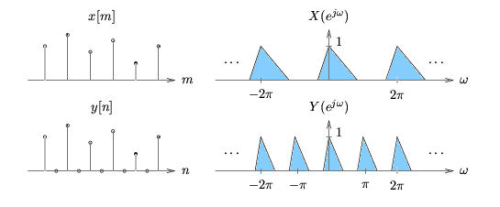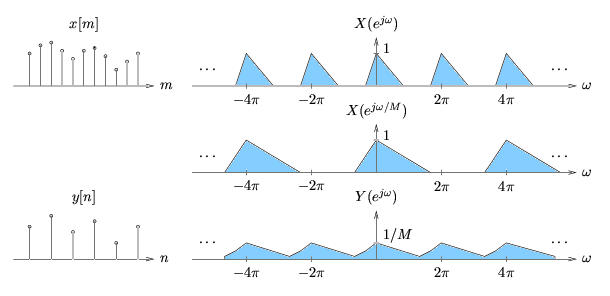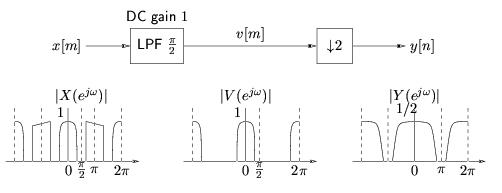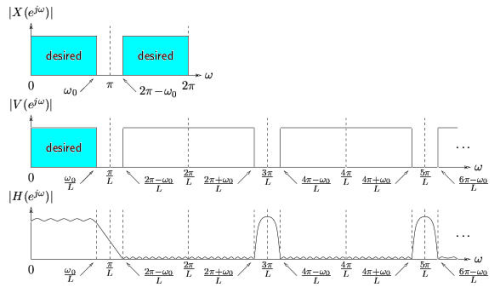Chapter 4. Multirate Signal Processing
The operation of upsampling by factor
L∈ℕ
describes the insertion of
L−1
zeros between every sample of the input signal. This is
denoted by
"
↑L
" in block diagrams, as in Figure 4.1.
Formally, upsampling can be expressed in the time domain as
 In the z-domain,
In the z-domain,
 and substituting
z=ⅇⅈω
for the DTFT,
and substituting
z=ⅇⅈω
for the DTFT,
()
Y(ⅇⅈω)=X(ⅇⅈωL)
As shown in Figure 4.2, upsampling
compresses the DTFT by a factor of
L along with the
ω axis.
The operation of downsampling by factor
M∈ℕ
describes the process of keeping every
Mth
sample and discarding the rest. This is denoted by "
↓M
" in block diagrams, as in Figure 4.3.
Formally, downsampling can be written as
y[n]=x[nM]
In the z domain,
()
where

()
Translating to the frequency domain,
()
As shown in Figure 4.4, downsampling expands each
2π
-periodic repetition of
X(ⅇⅈω)
by a factor of M along the
ω axis, and reduces the gain
by a factor of M. If
x[m] is not bandlimited to
 ,
aliasing may result from spectral overlap.
,
aliasing may result from spectral overlap.
When performing a frequency-domain analysis
of systems with up/downsamplers, it is strongly recommended to
carry out the analysis in the z
-domain until the last step, as done above. Working
directly in the
ⅇⅈω-domain can easily lead to errors.
4.4. Application of Interpolation - Oversampling in CD Players*
Application of Interpolation- Oversampling in CD Players
The digital audio signal on a CD is a
44.1kHz
sampled representation of a continuous signal
with bandwidth
20kHz
. With a standard ZOH-DAC, the analog reconstruction
filter would have passband edge at
20kHz
and stopband edge at
24.1kHz
. (See Figure 4.7) With
such a narrow transition band, this would be a difficult (and
expensive) filter to build.
If digital interpolation is used prior to reconstruction, the
effective sampling rate can be increased and the
reconstruction filter's transition band can be made much
wider, resulting in a much simpler (and cheaper) analog
filter. Figure 4.8 illustrates the
case of interpolation by 4. The
reconstruction filter has passband edge at
20kHz
and stopband edge at
156.4kHz
, resulting in a much
wider transition band and therefore an easier filter design.
Decimation is the process of filtering and downsampling a signal
to decrease its effective sampling rate, as illustrated in Figure 4.9. The
filtering is employed to prevent aliasing that might otherwise
result from downsampling.
To be more specific, say that
xc(t)=xl(t)+xb(t)
where
xl(t)
is a lowpass component bandlimited to
 Hz and
xb(t)
is a bandpass component with energy between
Hz and
xb(t)
is a bandpass component with energy between
 and
and
 .
If sampling
xc(t)
with interval T
yields an unaliased discrete representation
x[m], then decimating
x[m] by a factor
M will yield
y[n], an unaliased
MT-sampled
representation of lowpass component
xl(t)
.
.
If sampling
xc(t)
with interval T
yields an unaliased discrete representation
x[m], then decimating
x[m] by a factor
M will yield
y[n], an unaliased
MT-sampled
representation of lowpass component
xl(t)
.
We offer the following justification of the previously described
decimation procedure. From the sampling theorem, we have

The bandpass component
Xb(ⅈΩ)
is the removed by
 -lowpass
filtering, giving
-lowpass
filtering, giving
 Finally, downsampling yields
Finally, downsampling yields
()
which is clearly a MT-sampled version of
xl(t)
.
A frequency-domain illustration for
M=2
appears in Figure 4.10.
4.6. Resampling with Rational Factor*
Interpolation by L and decimation
by M can be combined to change the
effective sampling rate of a signal by the rational factor
 . This process is called resampling or
sample-rate conversion. Rather than cascading an
anti-imaging filter for interpolation with an anti-aliasing
filter for decimation, we implement one filter with the minimum
of the two cutoffs
. This process is called resampling or
sample-rate conversion. Rather than cascading an
anti-imaging filter for interpolation with an anti-aliasing
filter for decimation, we implement one filter with the minimum
of the two cutoffs
 and the multiplication of the two DC gains
(L and
1), as illustrated in Figure 4.11.
and the multiplication of the two DC gains
(L and
1), as illustrated in Figure 4.11.
4.7. Digital Filter Design for Interpolation and Decimation*
First we treat filter design for interpolation.
Consider an input signal
x[n]
that is
ω0-bandlimited in the DTFT domain.
If we upsample by factor
L to get
v[m]
, the desired portion of
V(ⅇⅈω)
is the spectrum in
 ,
while the undesired portion is the remainder of
[–π, π)
.
Noting from Figure 4.12 that
V(ⅇⅈω)
has zero energy in the regions
,
while the undesired portion is the remainder of
[–π, π)
.
Noting from Figure 4.12 that
V(ⅇⅈω)
has zero energy in the regions
()
the anti-imaging filter can be designed with transition bands in
these regions (rather than passbands or stopbands). For a given
number of taps, the additional degrees of freedom offered by
these transition bands allows for better responses in the
passbands and stopbands. The resulting filter design
specifications are shown in the bottom subplot below.
Next we treat filter design for decimation. Say that the
desired spectral component of the input
signal is bandlimited to
 and we have decided to downsample by M.
The goal is to minimally distort the input spectrum over
and we have decided to downsample by M.
The goal is to minimally distort the input spectrum over
 , i.e., the post-decimation
spectrum over
[–ω0, ω0)
, i.e., the post-decimation
spectrum over
[–ω0, ω0)
































